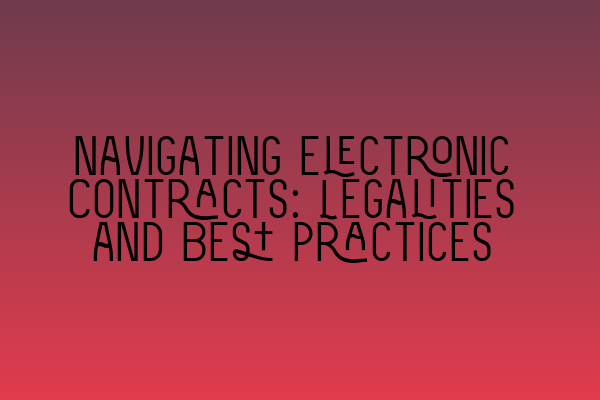In today’s digital age, electronic contracts have become increasingly prevalent in business transactions. However, the convenience of electronic contracts does not diminish the need for legal understanding and adherence to best practices. To ensure that you are navigating electronic contracts effectively and avoiding potential legal pitfalls, this article will explore the legalities surrounding electronic contracts and provide best practices to follow.
Before delving into the specifics, let’s first define what an electronic contract is. An electronic contract, also known as an e-contract, is an agreement or legal document that is created, signed, and stored electronically. These contracts may take various forms, such as online agreements, terms and conditions, purchase orders, and electronic signatures. With the rise of e-commerce and online business transactions, electronic contracts have become essential tools for modern businesses.
Legalities of Electronic Contracts:
1. Validity:
Electronic contracts are considered legally binding and enforceable as long as they meet certain criteria. These criteria include offer and acceptance, intention to create legal relations, consideration, and capacity. It is important to note that electronic contracts are subject to the same legal principles as traditional contracts.
2. Electronic Signatures:
One key aspect of electronic contracts is electronic signatures. An electronic signature is a digital representation of a person’s intent to agree to the terms of a contract. The law recognizes electronic signatures as valid, provided they meet specific requirements. These requirements typically include the signer’s intent to sign, their identification, and the ability to associate the signature with the relevant contract.
3. Consent and Notice:
In electronic contracts, obtaining consent and providing notice are essential for ensuring the enforceability of the agreement. It is important to obtain clear and unambiguous consent from all parties involved. This can be achieved through checkboxes, “I agree” buttons, or other explicit actions signaling agreement. Additionally, providing notice electronically should be done in a manner that ensures the recipient has received and understood the information, such as through registered email or secure online portals.
Best Practices for Navigating Electronic Contracts:
1. Clear and Understandable Language:
When drafting electronic contracts, it is crucial to use clear and understandable language. Avoid using excessive legal jargon or complicated terminology that may confuse the parties involved. Clear and concise language helps ensure that all parties fully comprehend the terms and conditions of the agreement.
2. Incorporate Electronic Signature Solutions:
To streamline the signing process, consider utilizing electronic signature solutions. These platforms provide secure and efficient methods for obtaining signatures, reducing the time and effort involved in the signing process. There are various reputable electronic signature providers available, such as DocuSign and Adobe Sign.
3. Retain Proper Documentation:
Maintaining proper documentation is critical when dealing with electronic contracts. It is essential to keep records of the entire contract creation process, including the offer, acceptance, terms, and signatures. These records can serve as evidence in case of disputes or legal issues.
4. Ensure Security and Data Protection:
Given the sensitive nature of information exchanged during electronic contracts, it is crucial to implement robust security measures. This includes employing encryption methods, utilizing secure servers, and implementing access controls to protect confidential data. Adhering to data protection regulations, such as the General Data Protection Regulation (GDPR), is essential to safeguarding personal information.
5. Regularly Review and Update Contracts:
As with any legal agreements, electronic contracts should be reviewed and updated periodically. Changes in laws or business practices may necessitate modifications to contractual terms. Regularly reviewing and updating contracts ensures that they remain compliant, effective, and reflective of the current business environment.
Navigating electronic contracts requires a sound understanding of the legalities surrounding them and adherence to best practices outlined above. By incorporating these best practices into your electronic contracting processes, you can navigate the complexities of electronic contracts while minimizing legal risks.
To dive deeper into the legal aspects of contracts, explore the following related articles:
1. Exploring the Impact of Frustration on Contractual Obligations: Legal Insights
2. Interpreting Contractual Clauses: Unlocking the Hidden Meanings
3. Legal Aspects of Business Contracts: Key Considerations for Entrepreneurs
4. Agreements in Contract Law: Understanding Its Various Types
5. Essentials of Consideration: Understanding the Basis of Contractual Exchange
Remember, electronic contracts can streamline business processes, but adequate legal understanding and adherence to best practices are essential for their successful implementation.
